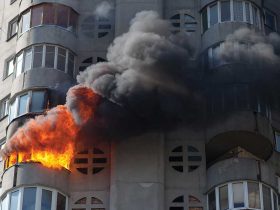On December 27, 2006, a three-alarm fire occurred in a 16-story fully sprinklered residential building known as Plumley Village. The fire attacked the building located at 16 Laurel Street in Worcester, Massachusetts, at about 4:30 a.m. Plumley Village consists of a sixteen-building complex built in 1972. It has fifteen low-rise buildings and one high-rise building.
The active fire protection for the high rise building consisted of automatic sprinkler protection installed to meet the requirements of NFPA 13, Standard for the Installation of Sprinkler Systems in accordance with the Commonwealth of Massachusetts State Building Code.
Upon arrival, the fire department discovered the fire involved the electrical equipment rooms on the eleventh, twelfth, thirteenth, fourteenth and fifteenth floors.
Subsequent investigation attributed the cause of the fire to water leaking from a faulty pressure relief valve on the seventeenth floor of the building. The water flowed into the building’s electrical system causing fire and smoke on the twelfth floor. The fire then extended downward to the eleventh floor and upward through the fifteenth floor.
Worcester, Massachusetts, fire officials reported that this represented one of the most labor intensive fire calls in the city’s history. Eight engines, five ladder trucks, a heavy rescue truck, five chief officers, and 45–50 firefighters responded to the three-alarm fire.
Early rescue efforts successfully evacuated the tenants. No lives were lost.
During the initial fire suppression efforts, the fire district chief in charge ordered the utility companies to disconnect power and gas to the building. This disconnection also interrupted the natural gas supply to the building’s emergency generator.


As he has done for the last fourteen years, Robert Horgan, senior wire inspector for the city, responded to the fire scene to assist the fire department. When he arrived, just minutes after the firefighters reached the scene, he reported to the district chief in charge. He found the emergency power to the elevators had failed, hampering firefighting efforts. The district fire chief and building maintenance superintendent accompanied Inspector Horgan to the basement location of the emergency generator. Upon inspection of the generator, he discovered that the natural gas utility company had shut-off all gas to the building, as ordered. He immediately had representatives of the utility isolate the gas feed to permit it to directly feed the generator.
The utility company then restored the natural gas supply to the generator and Horgan successfully restarted the generator.
He knew that sometime during 2004, a contractor had replaced the electric power feed to the elevators in order to comply with a change in the Massachusetts Electrical Code (National Electrical Code with Massachusetts amendments). That code change required the power feed to at least one elevator to maintain survivability during a two-hour fire exposure. He knew that the electrical contractor had installed listed fire-rated RHW cable in a 3-inch conduit from the emergency generator to the elevator power distribution panel located on the seventeenth floor penthouse.
After restoring the emergency generator, Horgan closed the circuit breaker for the elevator power and it remained closed. The first responders then used the ele-vator during the balance of the firefighting efforts.
NFPA 70, National Electrical Code, has required elevator power circuit survivability during a fire for over ten years. The Code recognizes fire-rated power and circuit integrity (CI) fire alarm cable as one of the methods to achieve the required survivability from fire. The NEC requires that cables used for survivability of critical circuits be listed as one of these types. The NEC also states in a fine print note (FPN) that one method of defining circuit integrity is by establishing a minimum 2-hour fire resistance rating when tested in accordance with UL 2196-2002, Standard for Tests of Fire Resistive Cables.

Photo 3. Fire-rated cable installed in 3-inch conduit next to buss duct; note the distance of the conduit from the buss duct
Inspector Horgan knew from discussions at electrical inspector meetings, and from his knowledge of the Code, that fire-rated cables offered an approved method to comply with the survivability requirements. When the electrical contractor originally submitted the fire-rated cable for approval for the Plumley Village elevator emergency power upgrade, Inspector Horgan immediately approved its use for this installation.
After the fire suppression operations had proceeded through overhaul, Inspector Horgan began a further investigation into the cause of the fire. He also began to assess whether or not a contractor could begin to safely restore the electrical system to allow the building occupants to return to their apartments.
When Inspector Horgan inspected the twelfth floor electrical room, he found the buss duct blown apart. Approximately 3 feet of the copper buss had presumably disintegrated from the heat (see photos 1 and 2). All of the other wiring in the electrical closet had failed electrically. The contractor had installed the fire-rated power feeder cables to the elevators in a location approximately 9–12 inches away from the buss duct that disintegrated from the heat of the fire.
Although a complete automatic sprinkler system protected required areas of the building except the electrical closets, no sprinkler heads operated. The two-hour fire-rated eleventh- and twelfth-floor electrical closets contained the fire.
Although not part of the initial investigation, it was found that this fire also caused the failure of the fire alarm/voice communication system. Unfortunately the fire alarm system wiring was located in the same electrical rooms as the fire. According to the first responders, the fire alarm notification circuits’ failure occurred within 70 to 120 seconds after the first responders arrived on the scene. Presumably, the other “”normal”” electrical circuits failed at approximately the same time. This event helps to substantiate that CI cable for critical circuits like the speaker circuits of a fire alarm/voice communication system should be used regardless of the building structure or building protection provided by automatic sprinklers, unless the sprinkler system protects the actual cable installation.
The expected performance of the fire-rated cable that maintained the power to the elevator, even after all other circuits had failed, remains a unique factor of this fire. The UL 2196 qualified fire-rated cable survived when exposed to a very hot electrical fire. The location of the cable, within 9–12 inches of the melting copper buss duct (at temperatures > 1900° F), certainly validated its anticipated operation.
Craig Bonner, the building maintenance superintendent, repeatedly stated the importance of the elevator operation in the building restoration operations during the assessment and early repair stages, well before a contactor replaced the existing cable. To assure continued expected performance during any future fire, the electrical contractor has now replaced the original cable with new fire-rated cables, also supplied by the original manufacturer.
Inspector Horgan remains very pleased with the outcome of the emergency power issues. He says that the most important thing to him: “…the stuff just worked!”










Find Us on Socials